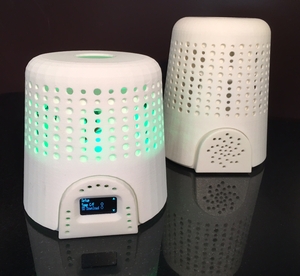Could Our School Buildings Be Hurting Our Students’ Exam Performance?

Substandard teaching, lack of revision and jitters on the day tend to be the things most people blame for poor exam results – but what if the exam venue itself is working against you?…

- by Teachwire

Professor Stephen Heppell has made it his business to investigate how people’s surroundings can affect their ability to learn – or not, as the case may be.
 The school teacher turned academic made headlines last month, with the suggestion that having children not wear shoes in class could help to improve their behaviour and reduce instances of bullying.
The school teacher turned academic made headlines last month, with the suggestion that having children not wear shoes in class could help to improve their behaviour and reduce instances of bullying.
The finding came from Heppell’s observations of pupils and classrooms in Scandinavia while working on his ongoing ‘Learnometer’ research project – an ambitious attempt to measure and quantify the impact of various environmental factors on children’s learning in schools throughout the world.
Central to the project is the Learnometer tracking device itself (pictured below) – a 3D-printed enclosure containing a number of sensors and detectors that schools can use to measure levels of ambient noise, air quality and light levels. The data gathered by the Learnometers over time is then analysed by Heppell and his colleagues to ascertain the ambient conditions that are most conducive to learning – and which aren’t.
Heppell envisages the project continuing for the next couple of years, and is keen for more schools get involved. ‘We’ve been doing it since 2014 and have got a lot of information back,’ he explains, but now we want a lot of data.’
 The project has also seen the launch of a Kickstarter campaign to help fund the manufacture of the team’s third Learnometer prototype. According to Heppell, ‘Schools can sign up to take part at learnometer.net and we’ll send them the research for free as it comes out. They can put their names down to purchase a box, which we’re selling at cost’.
The project has also seen the launch of a Kickstarter campaign to help fund the manufacture of the team’s third Learnometer prototype. According to Heppell, ‘Schools can sign up to take part at learnometer.net and we’ll send them the research for free as it comes out. They can put their names down to purchase a box, which we’re selling at cost’.
Shoeless learning aside, the Learnometer project has also highlighted what Heppell sees as a particularly pressing issue with school exam rooms and halls across the world – that their ambient conditions may be sabotaging candidates’ chances of passing.
‘We haven’t found one that’s actually ideal,’ Heppell says. ‘We haven’t found any yet that aren’t damaging the children’s prospects – it’s that bad.’
Heppell bases this verdict on Learnometer recordings taken at 56 schools across a dozen countries within the last year. We asked him to expand a little more on how building interiors can affect pupils’ exam performance, based on the data gathered so far…
Light levels
The best practice for schools is to maintain light levels of over 500 lumens; even at 100 or 200 lumens, you’ll find that kids can’t concentrate and are unable to perform at their best. We’ve been into exam rooms where the lumen count is in double figures – I think the lowest I saw was 39. You just couldn’t work in there.
Worst of all is when half the kids in a room are in good light and the other half in bad light, because you get hugely unfair results.
During our observations we found that many school buildings use limited amounts of glass and have walls don’t reflect light very well – which isn’t helped when there’s a lot of paper on the glass in the form of posters and such.
Temperature and humidity
Physiologically, things will start going wrong above 21°C, which is actually quite cool. Unfortunately the answer isn’t necessarily to crank up the air conditioning, because AC systems and fans can produce sounds that are too loud, or fast rhythms – rapid rhythmic noise, even quietly, can be very distracting.
The solution lies in having the right architecture, but also appropriate furniture and fixtures. Having big fans in the ceiling will help move air around without causing drafts that will blow away exam papers, and also provide extra ventilation – which is necessary because of the CO2 problem.
CO2 levels
Placing 200 breathing kids in one room will cause the room to exceed critical CO2 levels within 30 minutes. Teachers have told us that when they’re invigilating, they’ll start to feel sleepy after about half an hour. What’s happening is that the room is filling up with CO2. The teacher will then often get up and walk around, which makes their head temporarily come out of this CO2 ‘bath’. They’ll feel like they’ve woken up a bit and sit back down, but the kids can’t do that.
The solution is proper ventilation, extraction, keeping windows and doors open – it’s common sense stuff, really, but something people tend not to think about. If you look at the design of school buildings in Australia, for example, where temperatures are quite high, they’ll often have an overhanging roof and a verandah. Those old verandah-style schools are very good at creating airflow, whereas newer designs often aren’t. We’ve neglected to look back at what worked in the past.
Sound volume/rhythms
I can’t think of any halls we visited where the ambient sound levels were too loud, but I can think of plenty with background sound rhythms were too fast – usually due to the aircon or a cheap, noisy fan.
Air pollution
At the simplest level, this could amount to somebody suffering with hay fever during their exams in May or June and doing less well as a result. In urban areas, air pollution could extend to students coughing, wheezing or rubbing their eyes.
It may be that we’re simply holding exams at the wrong time of year. Once the data can tell us when air pollution is at it’s peak in schools, we’ll be able to explain to policymakers that holding exams in February may be fairer.
Back to class
A school’s interior spaces don’t just affect those taking exams, of course – what about the classrooms and learning spaces in which pupils are taught all year round?
According to Heppell, these are the top five environmental habits and practices that schools should avoid if they don’t want to adversely affect their pupils’ behaviour and academic performance…
1. Never altering room layouts Schools will often arrange classrooms so that the desks are always in the same place and the same position, with nothing ever changing. There’s not a kid on the planet who would be anything other than disengaged after a month, never mind a year of that.
2. Wasting potential learning spaces Schools can often have lots of space available for moving pupils around, but classrooms that feel squashed. There might be wide corridors everywhere, but the kids won’t do any learning in them, which seems crazy to me.
Think about moving the kids around a bit more – maybe there’s a Skype facility set up somewhere for talking to other schools, or research displays in the corridors. Getting kids moving in and out of classrooms will help improve air flow, get them using their legs – there are lots of obvious advantages.
3. Instructing pupils to sit at all times In most classrooms the pupils can only sit – there won’t be any standing height tables for them to use. In lots of public spaces – coffee shops, for example – you can stand up, sit on a chair at a table, sit on a sofa; the people in them have different options. If you’re trying to keep the attention of kids in a classroom, so should they.
4. Failing to make full use of classroom space If you haven’t already, try zoning the classroom by having, say, a reading corner, a research corner, a collaboration space – perhaps a ‘heads down and working without talking’ space. Zoning the room according to different learning activities means the children move round more and you can keep the learning fresh. Many schools already do this, but a lot don’t, and it makes a big difference.
5. Obscuring glass and windows Glass is there to let light into the building, and yet many schools insist on having things stuck to it, such as posters. The thing is, you can write on windows – if you use a special marker pen, they make great whiteboards. Get rid of the paper and let the sun shine in.
Further details about the Learnometer project can be found here; for more information about Professor Stephen Heppell’s work, visit www.heppell.net or follow @stephenheppell











